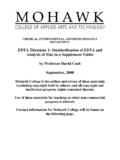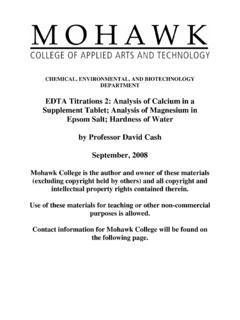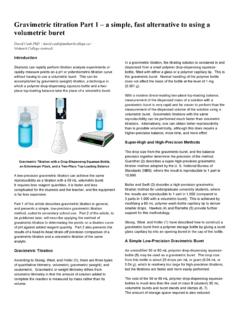Transcription of Paper Chromatography of Food Colour Dyes by Professor ...
1 CHEMICAL, ENVIRONMENTAL, AND BIOTECHNOLOGY DEPARTMENT Paper Chromatography of Food Colour Dyes by Professor David Cash September, 2008 Mohawk College is the author and owner of these materials (excluding copyright held by others) and all copyright and intellectual property rights contained therein. Use of these materials for teaching or other non-commercial purposes is allowed. Contact information for Mohawk College will be found on the following page. This Experiment is a 2 hour General Chemistry laboratory exercise. It is designed for students in the common first term of a 2-year diploma program (Biotechnology, Environmental, or Health Technician).
2 For Information or Assistance Contact: MOHAWK COLLEGE CHEMICAL, ENVIRONMENTAL, AND BIOTECHNOLOGY DEPARTMENT Professor Cindy Mehlenbacher 905-575-1212 ext. 3122 Bill Rolfe (Chief Technologist) 905-575-2234 1 Experiment 11 Paper Chromatography OBJECTIVE A number of pure substances and mixtures of pure substances in solution will be analyzed by the method of Paper Chromatography . The retention factor (Rf value) of each individual substance will be measured. The Rf value of each component of a mixture will be measured and compared to the Rf values of the individual substances, in order to identify the substances present in the mixture.
3 Substances will be separated using Paper Chromatography . Retention factor (Rf) values will be determined. The component substances in mixtures will be identified by comparison of Rf values. REFERENCES Wikipedia URL Pencil Graphite Chromatography Gas Chromatography high performance liquid Chromatography 2 INTRODUCTION Chromatography Some analytical methods can be applied to samples which contain mixtures of substances, but most methods require that the components of the sample be separated first. Chromatography is the general name of a very important group of closely related separation methods.
4 These methods use the differing physical properties of the substances to separate them. The method and name was invented around 1900 by a chemist (Tswett) who was able to separate the coloured pigments from plants, the yellow and red carotenes and the green chlorophylls, by passing an extract of pigments through a column packed with powdered chalk or sugar. The name Chromatography means writing with Colour . The method was not important at that time because most substances are not visibly coloured, and the only detector available at the time was the human eye.
5 Modern Chromatography The first modern use of Chromatography came in the 1940 s. The biochemists studying proteins recognized that all protein was made from only 20+ component amino acids. Hydrolysis of purified proteins gave mixtures of amino acids that were impossible to separate by the classical methods, such as distillation or fractional crystallization. The chemists Martin and Synge developed Paper Chromatography as a method of amino acid separation, and were awarded the Nobel Prize in Chemistry (1952) for this and further work. Paper Chromatography and its close relative thin layer Chromatography (TLC) are still very important methods used today.
6 Since 1950, new methods called gas Chromatography (GC) and high pressure/ performance liquid Chromatography (HPLC or LC) have been introduced which are even more important. The theory and practice of GC and HPLC are introduced in Chemical Instrumentation and Sampling and Analysis courses. A Paper Chromatography Experiment If you have ever put a drop of liquid ink on a piece of blotting Paper or filter Paper and seen the different colours of ink separate, you have done a Chromatography experiment. The Paper is a very open (porous) material composed of cellulose fibres.
7 The ink is a solution of pigment (light absorbing) substances in water. The water of the ink moves into the Paper by a surface action called capillary action. Capillary action can move water or other liquids through porous Paper in any direction, up, across or down, and for great distances. The dissolved ink pigments will tend to flow with the water, but the surface of the Paper fibres also attracts them. The pigment molecules spend some of their time in the water, moving, and some of their time on the Paper surface, not moving.
8 This Section Continues on the Next Page 3 A Paper Chromatography Experiment (Cont.) Suppose that an ink has three pigments, one blue (B), one yellow (Y) and one green (G). A piece of porous Paper ( Chromatography Paper ) is cut into a rectangle. A pencil line is drawn about 2 cm from the short end and an x is marked on the line. A small spot of ink is placed on the x-mark (origin) and allowed to dry. Some water is placed in a beaker to a depth of about 1 cm, and the Paper is hung vertically into the water, but the pencil line is above the surface.
9 The solvent moves up the Paper by capillary action, and soon crosses the ink spot, which looks green to the eye. As it moves up, each ink pigment molecule may at one time be dissolved in the water and move up the Paper or may at another time stay on the Paper surface and remain stationary. Since each substance is different, often they will move different distances. Suppose the water front has moved 10 cm from the pencil line when the experiment is stopped, the front line is marked in pencil, and the Paper is taken out and dried.
10 The ideal situation is that the three pigments are now separated into a blue spot, a yellow spot and a green spot. The distance from the x-mark to the centre of each spot is measured: the distances are cm (blue), cm (yellow) and cm (green). The experiment has been successful in that it is obvious that there were three pigments in the ink, not one. See the Box below for a representation of the experiment. Box: Paper Chromatography of an Ink Paper (Initial)Origin withInk SpotPaper (Final)Green Spot cmYellow Spot cmBlue Spot cmSolvent Front cmxx Cash / ChemDraw / 2001 4 Technical Terms in Paper Chromatography Water is not often used as a solvent for Chromatography , since better separations are usually achieved with mixed solvents.





